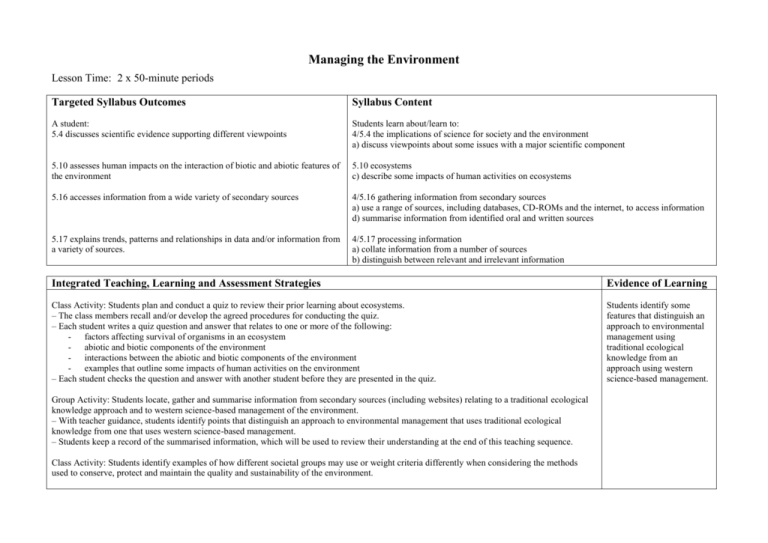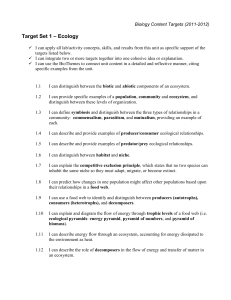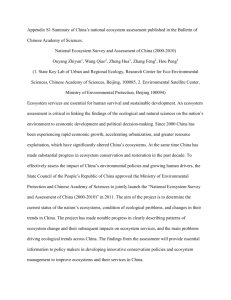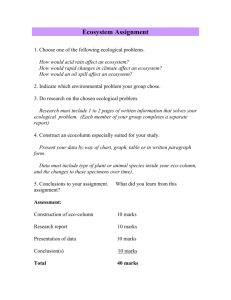Managing the Environment - Science 7
advertisement

Managing the Environment Lesson Time: 2 x 50-minute periods Targeted Syllabus Outcomes Syllabus Content A student: 5.4 discusses scientific evidence supporting different viewpoints Students learn about/learn to: 4/5.4 the implications of science for society and the environment a) discuss viewpoints about some issues with a major scientific component 5.10 assesses human impacts on the interaction of biotic and abiotic features of the environment 5.10 ecosystems c) describe some impacts of human activities on ecosystems 5.16 accesses information from a wide variety of secondary sources 4/5.16 gathering information from secondary sources a) use a range of sources, including databases, CD-ROMs and the internet, to access information d) summarise information from identified oral and written sources 5.17 explains trends, patterns and relationships in data and/or information from a variety of sources. 4/5.17 processing information a) collate information from a number of sources b) distinguish between relevant and irrelevant information Integrated Teaching, Learning and Assessment Strategies Evidence of Learning Class Activity: Students plan and conduct a quiz to review their prior learning about ecosystems. – The class members recall and/or develop the agreed procedures for conducting the quiz. – Each student writes a quiz question and answer that relates to one or more of the following: - factors affecting survival of organisms in an ecosystem - abiotic and biotic components of the environment - interactions between the abiotic and biotic components of the environment - examples that outline some impacts of human activities on the environment – Each student checks the question and answer with another student before they are presented in the quiz. Students identify some features that distinguish an approach to environmental management using traditional ecological knowledge from an approach using western science-based management. Group Activity: Students locate, gather and summarise information from secondary sources (including websites) relating to a traditional ecological knowledge approach and to western science-based management of the environment. – With teacher guidance, students identify points that distinguish an approach to environmental management that uses traditional ecological knowledge from one that uses western science-based management. – Students keep a record of the summarised information, which will be used to review their understanding at the end of this teaching sequence. Class Activity: Students identify examples of how different societal groups may use or weight criteria differently when considering the methods used to conserve, protect and maintain the quality and sustainability of the environment. Managing the Environment (cont.) Lesson Time: 3 x 50-minute periods Targeted Syllabus Outcomes Syllabus Content A student: 5.4 discusses scientific evidence supporting different viewpoints 5.18 selects and uses appropriate forms of communication to present information to an audience 4/5.24 respects differing viewpoints on science issues and is honest, fair and ethical 4/5.26 recognises the role of science in providing information about issues being considered and in increasing understanding of the world around them Students learn about/learn to: 4/5.4 the implications of science for society and the environment b) give examples to show how different cultures or groups within a society (including Aboriginal and other Indigenous people) may use or weight criteria differently to make a decision about an issue involving a major scientific component 4/5.18 presenting information e) use drawings, diagrams, graphs, tables, databases, spreadsheets and flowcharts to show relationships and present information clearly and/or succinctly Integrated Teaching, Learning and Assessment Strategies Evidence of Learning Individual/Group Activity: Students investigate the application of traditional ecological knowledge to the management of an Australian ecosystem. Students: – locate and read a case study about the application of traditional ecological knowledge to the management of an Australian ecosystem, eg Indigenous fire practice in Western Arnhem Land: Lessons for today. – use an atlas to identify the location of the case study and record this on a blank map of Australia – describe some strategies used in managing an ecosystem using traditional ecological knowledge. Students use annotated drawings to clearly present information that compares some strategies applied to managing the sustainability of an ecosystem using traditional ecological knowledge with those that use a western science-based approach. Individual Activity: Students relate the changes in weather/seasons to the strategies used by traditional Aboriginal peoples in managing an ecosystem. Students: – use an Aboriginal yearly calendar for an area similar to that in the case study to identify the changes in the features of weather/seasons – construct a sequence of six labelled drawings/sketches to depict how the vegetation in the the area of the case study changes with the seasons, and as a result of the interactions with the Aboriginal people (see Case Study Worksheet: Indigenous Fire Practice in Western Arnhem Land). Individual/Group Activity: Students investigate the application of a western science-based approach to the management of an Australian ecosystem. Students: – locate and read a case study in which a western science-based approach is being applied to the management of an Australian ecosystem, eg To Burn or Not to Burn. – use an atlas to identify the location of the case study and record this on an outline map of Australia – describe some strategies used in the case study to manage the ecosystem – construct a sequence of six drawings/sketches with appropriate captions to depict a western science-based approach to managing an ecosystem. Managing the Environment (cont.) Lesson Time: 1 x 50-minute period Targeted Syllabus Outcomes Syllabus Content A student: 5.4 discusses scientific evidence supporting different viewpoints Students learn about/learn to: 4/5.4 the implications of science for society and the environment a) discuss viewpoints about some issues with a major scientific component b) give examples to show that different cultures or groups within society (including Aboriginal and other Indigenous people) may use or weight criteria differently to make a decision about an issue involving a major scientific component 5.11 analyses the impact of human resource use on the biosphere to evaluate methods of conserving, protecting and maintaining the quality and sustainability of the environment 5.17 explains trends, patterns and relationships in data and/or information from a variety of sources. 4/5.27 acknowledges their responsibility to conserve, protect and maintain the environment for the future 5.11.2 waste from resource use c) discuss strategies used to balance human activities and needs in ecosystems with conserving, protecting and maintaining the quality and sustainability of the environment 4/5.17 processing information d) organise data using a variety of methods including diagrams, tables, spreadsheets and databases Integrated Teaching, Learning and Assessment Strategies Evidence of Learning Class/Group Activity: Students compare the different knowledge systems and strategies used in the two approaches to environmental management described in the case studies (eg Traditional and non-traditional viewpoints: Arnhem Land Fire Stories). Students: – review and revise the initial points they recorded that distinguish an approach to environmental management using traditional ecological knowledge and western science-based management – construct a table to outline the advantages and disadvantages of the strategies used in each approach for managing Australian ecosystems. Individual/Group Activity: Students consider examples of how different groups including Aboriginal people may use or weight criteria differently in relation to managing the environment. Students: – identify the criteria used and describe the relationships between these and the strategies used in each case study to conserve, protect and maintain the quality and sustainability of an ecosystem – describe some examples in their everyday lives where strategies are used to conserve, protect and maintain the quality of the environment – with teacher guidance, use these examples to identify some of the different criteria people may use or weight differently in considering issues about conserving, protecting and maintaining the quality and sustainability of the environment. Students identify some examples of how Aboriginal peoples may use or weight criteria differently from other groups in society in relation to the control, protection and management of the environment. CASE STUDY: Indigenous Fire Practice in Western Arnhem Land 1. Wet season 2. Early dry season 3. Mosaic of burnt and unburnt areas 4. Main dry season 5. Vegetation in various stages of recovery 6. Fresh grass attracts large birds and macropods









